Most of the naval propulsion systems developed in the aftermath of WWII were intended to replace steam, which had dominated the field for a century. But one alternative was intended not to replace steam, but to generate it using a different heat source. Instead of buring coal or oil, Uranium atoms would be split, giving vast quantities of heat without the need for fuel or oxygen.
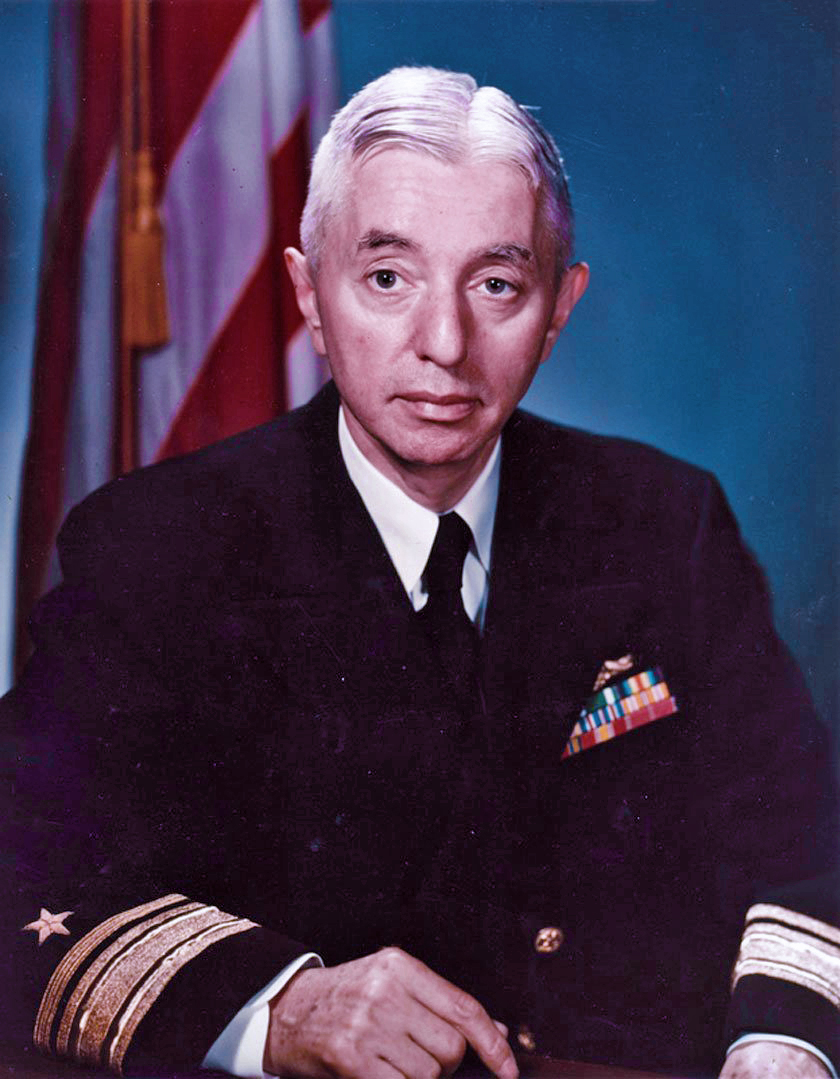
Hyman Rickover
Independence from oxygen made nuclear propulsion particularly attractive for submarines, who had been searching for ways to get greater underwater endurance than was possible on batteries. A number of methods had been tested, but results had ranged from "unsuccessful" to "ludicrously dangerous".1 The Navy put together a small team in 1946 to begin work on power reactors, led by an engineering officer by the name of Hyman Rickover. It proved to be an inspired choice. Rickover was a difficult man, prone to screaming at subordinates and more than a little obsessive, but also supremely effective at getting things done. He managed to set up an organization known as Naval Reactors under the joint control of the Navy and the Atomic Energy Commission (AEC), which allowed him to evade many of the Navy's bureaucratic obstacles.
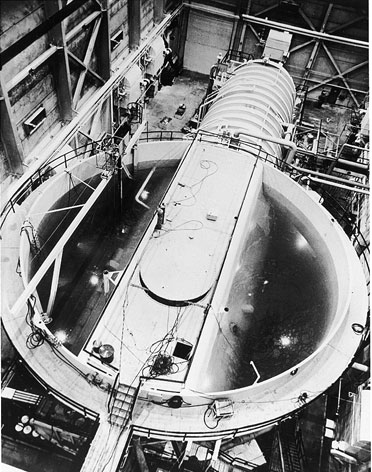
The Submarine Thermal Reactor test plant
The big question was how to get the heat out of the reactor and into the water that would make steam. The first studies looked at using a gas, but this was soon dropped, and attention turned to two options: water and liquid metal. Of the two, most preferred the liquid-metal cooled reactor. It could run at higher temperatures, getting more power in less space and weight, and producing superheated steam. The water-cooled reactor would be limited to wet steam, but could also use the cooling water to moderate the reaction, slowing down neutrons to the point where they could initiate fission. If the reactor produced too much power, it would heat up and the water would expand. As its density fell, it would be less effective as a moderator, and the reaction would slow down. In 1949, Rickover directed that effort would focus on the water-cooled Submarine Thermal Reactor, as it was simpler and thus closer to maturity, although work continued on the metal-cooled Submarine Intermediate Reactor.
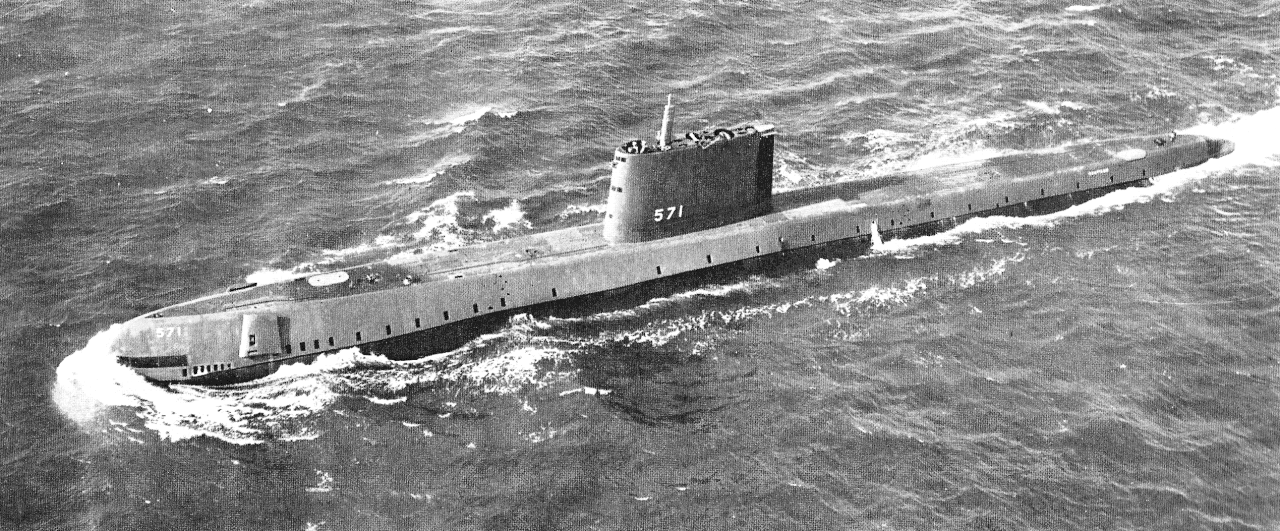
Nautilus on trials
Work proceeded quickly, with a prototype nuclear submarine ordered in FY50, despite the postwar budget crunch and the fact that the land-based prototype reactor didn't start operations until 1953. It was decided to build the boat as an operational prototype, including torpedo tubes. The result was Nautilus, which was "Underway on Nuclear Power" for the first time on January 17th, 1955. She was initially only expected to be able to make about 15,000 nm at full speed, which was about what a diesel-powered submarine could do, but in practice, she did four times that before her first refueling, and six times more before her second. Other problems had to be overcome as well, with air-conditioning installed to make sure the reactor didn't boil the crew, and a vastly improved air purification system, as Nautilus was, at last, a true underwater vessel, instead of a surface ship that could submerge for short periods. In service, she proved revolutionary thanks to her high speed and unlimited endurance and she was quickly followed by numerous other nuclear submarines.
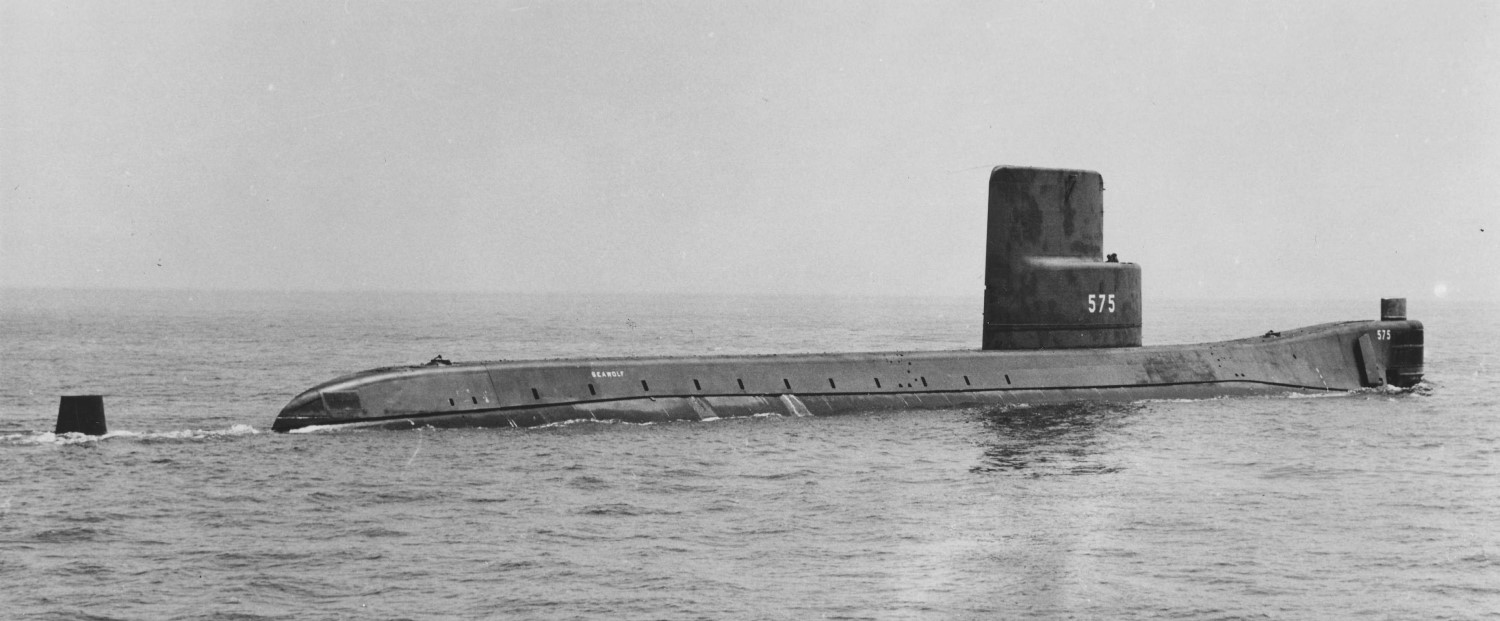
Seawolf
The US and Russia both attempted to build liquid-metal cooled reactors for their submarines, with the second US SSN, Seawolf, having a reactor that used liquid Sodium as coolant. It quickly developed leaks, which, as you'd expect with a highly corrosive metal that reacts violently on contact with water, was a serious problem. After only 20 months of operation at reduced power, she returned to the yard for conversion to a Pressurized Water Reactor (PWR) very similar to that used on Nautilus, and which has formed the basis for every US naval reactor since. Until Rickover's retirement in 1982, any mention of alternative reactor technology was met with fits, and no such projects have made it very far since then. The Soviets chose instead a Lead-Bismuth alloy for their liquid-metal reactors, and they were slightly more successful, with a single unit of the November class and all seven of the Alfa class using these reactors.2 Lead-Bismuth was less reactive than Sodium, but it was solid at room temperature, which meant that before the reactor could be shut down, it had to be hooked into a shore heating system to make sure the coolant didn't solidify. The prototype of this plant, on submarine K-27, suffered a serious accident in 1968, and the need to shut down the reactor ultimately doomed the submarine. A similar problem afflicted the first Alfa, who ran into reactor problems after less than a year in service, and was never repaired, while the next boat was out of service for almost a decade after a similar shutdown.
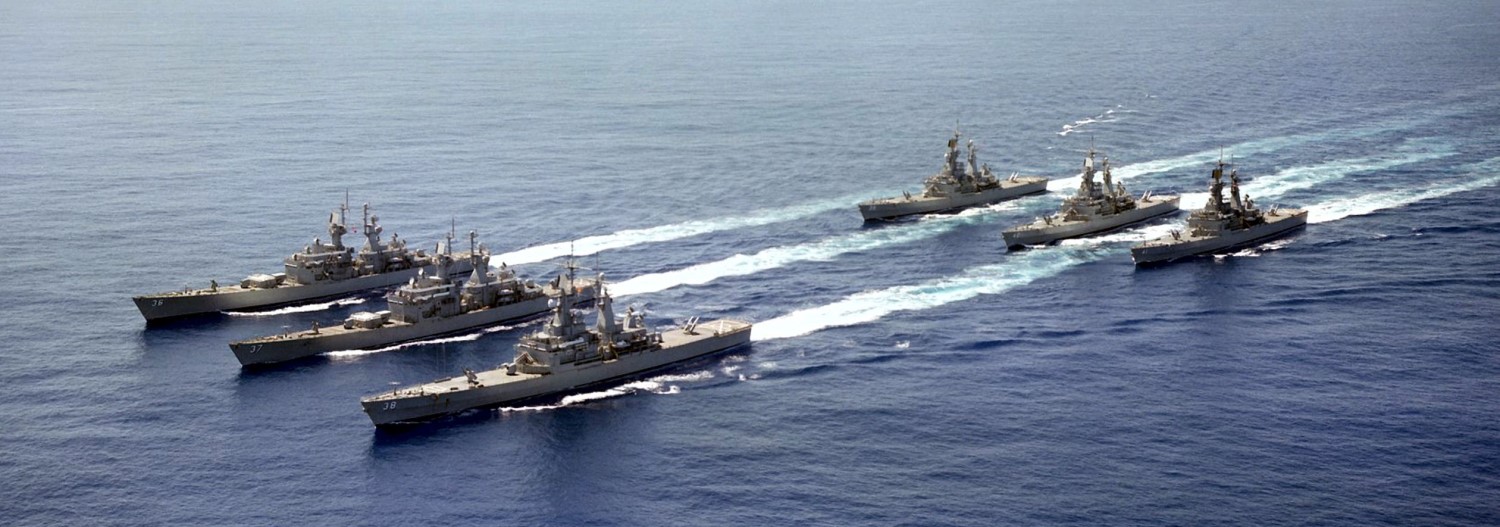
American nuclear cruisers operate together
The problems with these reactors meant that PWRs came to dominate naval nuclear propulsion, and continue to do so to this day. The Soviets got their first submarines to sea in 1959, followed four years later by the British, who built their first SSN, Dreadnought, around an American nuclear reactor. The French, Chinese and Indians later developed their own SSNs. Interest also grew in nuclear-powered surface ships. In theory, nuclear propulsion offered substantial advantages for surface ships, even if the rationale was not as clear-cut as for submarines. Initial work focused on smaller ships, which had traditionally been the endurance-limited portions of the fleet. Obviously, removing the need for fuel would be a major help, but nuclear power was expensive and pushed up displacement by about a thousand tons compared to a similarly-armed conventional ship in the 50s and 60s. That in turn tended to lead to more expensive combat systems, and higher overall costs. It also complicates design, as the naval architects can't use fluids to make up for any trim deficiencies, as the ship doesn't have nearly as many as an oil-burning vessel. The first nuclear surface combatant, the cruiser Long Beach, entered service in 1961, and was followed by eight more smaller nuclear cruisers over the next decade and a half. Ultimately, it ended up as a victim of tightening defense budgets when the need to get Aegis to sea cheaply led the nuclear escort program to be cut in favor of the Ticonderoga class. Unfortunately, this was the point at which combat system costs rose dramatically, greatly reducing the cost advantage of conventional propulsion.3 While this should have given the nuclear escort a new lease on life, the only major surface combatant developed since then, the Arleigh Burke class, was intended as a cheaper alternative to the Ticonderoga and obviously didn't use nuclear power. As a result, the only nuclear surface combatant still in operation today is the Russian Pyotr Velikiy, whose plant was discussed last time. But a congressional mandate that any surface warship over 8,000 tons needs nuclear propulsion (or a waiver) remains on the books, and there is still talk about applying nuclear power to the Ticonderoga replacement, even if this seems unlikely in practice.4
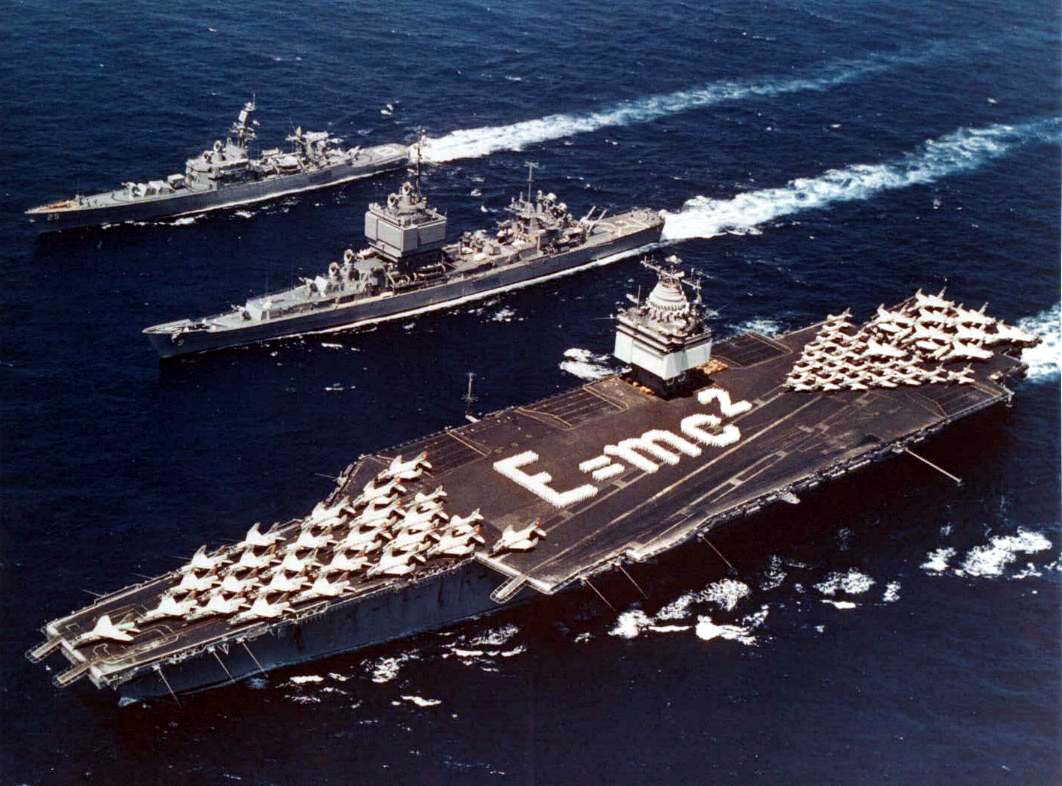
Enterprise, Long Beach and Bainbridge during Operation Sea Orbit
Interestingly, the aircraft carrier was the last type of surface ship where nuclear power was seriously considered, but it has proven by far the most successful. Initially, it was ignored for two main reasons: first, carriers already had great endurance, and as such, there wasn't a lot of reason to give them more. Second, while a nuclear-powered carrier might be able to steam indefinitely, the aircraft onboard would still use fuel and ordnance, and so she would have to replenish frequently anyway. However, with the commissioning of the eight-reactor Enterprise only a few months after Long Beach, the advantages began to be apparent. First, there are no exhaust gasses, which means no need for uptakes and no damage to aircraft topside from them. Second, modern carriers use a huge amount of energy catapulting planes and on electrical systems, and nuclear power means that these are not problems for the ship. Third, the ability to sustain high speed is valuable for deployment and countering submarines, although this is limited for modern carriers by the lack of nuclear escorts. These advantages proved so compelling that while the two carriers which followed Enterprise burned oil, every one of the 11 carriers the US has commissioned since 1975 has had a pair of nuclear reactors.
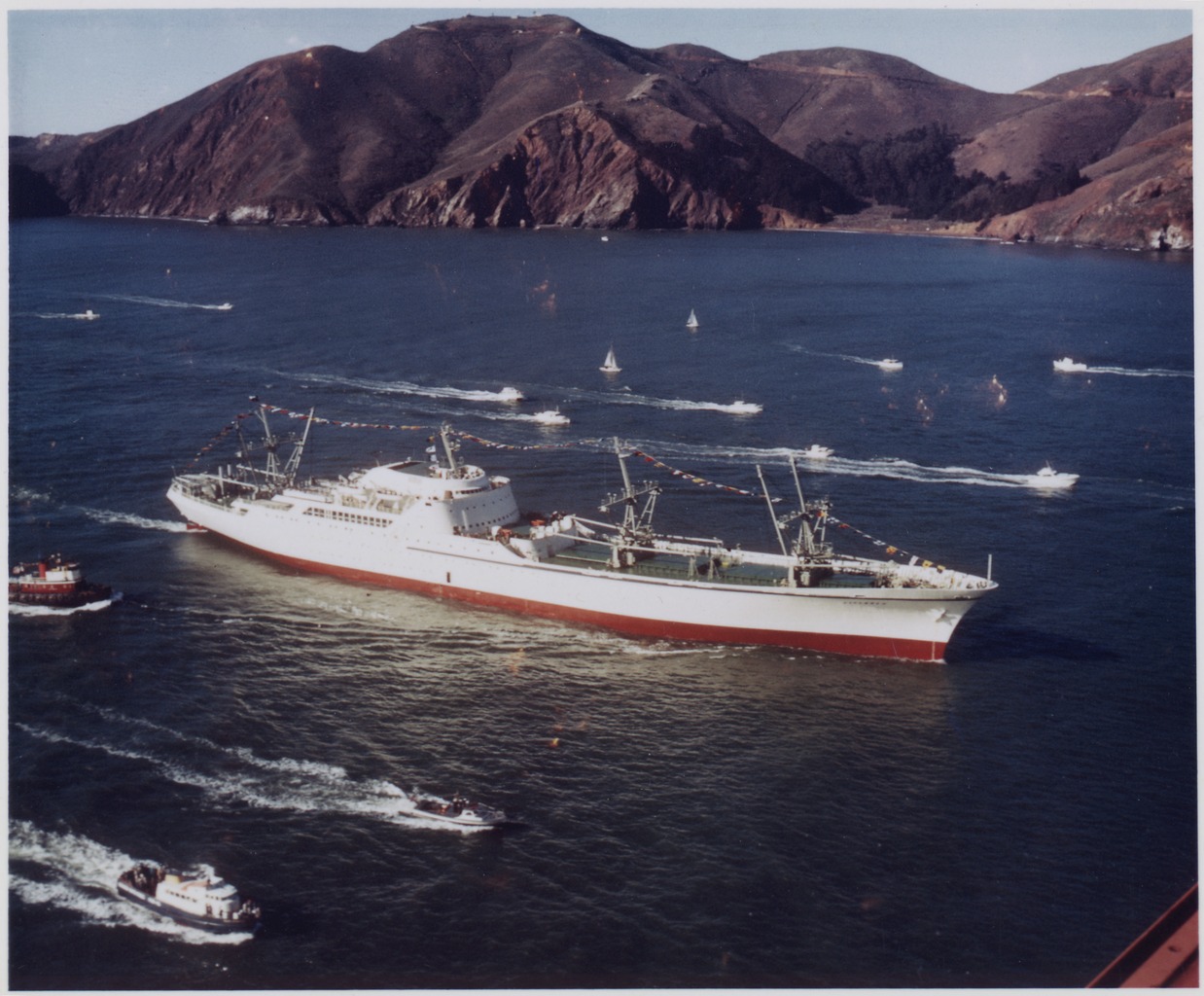
NS Savannah5
The early days of the nuclear age also saw interest in nuclear merchant ships, and the first, the Soviet icebreaker Lenin, actually beat the first Soviet nuclear submarine into service. Nuclear propulsion proved ideal for icebreakers, which need to use high power for long durations in an environment where fuel delivery is difficult and expensive. Today, the Russians operate four nuclear-powered icebreakers, and have three more under construction. Nuclear-powered cargo ships have been less successful. The Americans built NS Savannah as a demonstrator in the early 60s, but she served for only a decade and was not a commercial success. Similar efforts in Germany and Japan also failed, with both vessels being converted to diesel propulsion. The only arguable success in this field is the Russian Sevmorput, an icebreaking cargo ship that has lasted over 30 years.
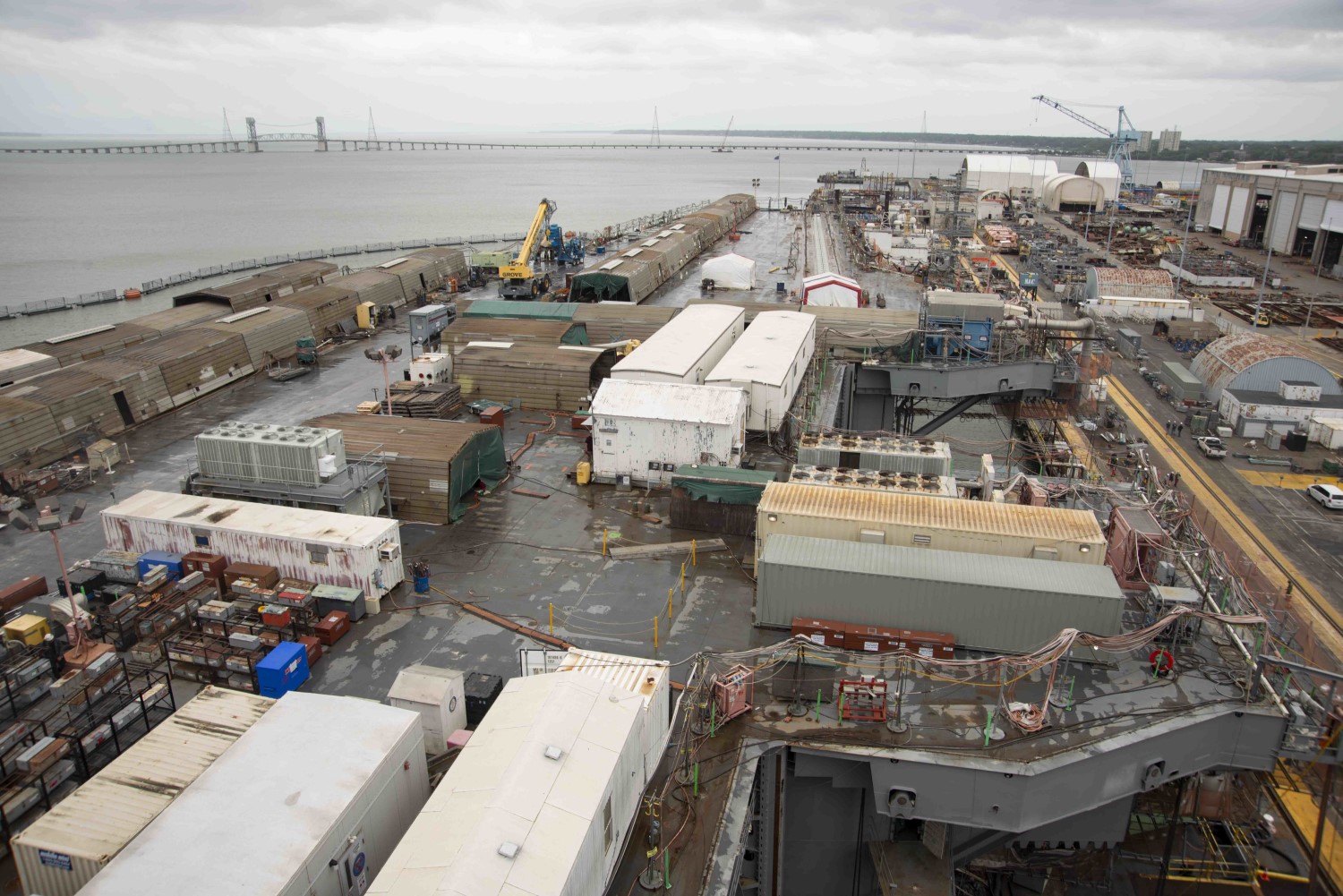
Equipment on the deck of George Washington during her refueling overhaul
Despite the dominance of the basic PWR architecture, a number of improvements have been made over the years. One of the most obvious is increasing intervals between refuelings, thanks to improved reactor technology. The first nuclear submarines needed refueling every 2 years or so, although this interval has steadily grown, with Enterprise going 3 years before her first refueling, 5 years before her second, while her third core, installed in the early 70s, lasted almost 20 years, as did her last one. More recent carriers are only refueled once, and the Seawolf and Virginia class submarines have lifetime reactors, which will operate for 30+ years without refueling, saving a lot of money on extremely expensive refuelings. These reactors use bomb-grade Uranium, and are laced with burnable poisons that are consumed as the Uranium is, maintaining relatively constant reactivity.
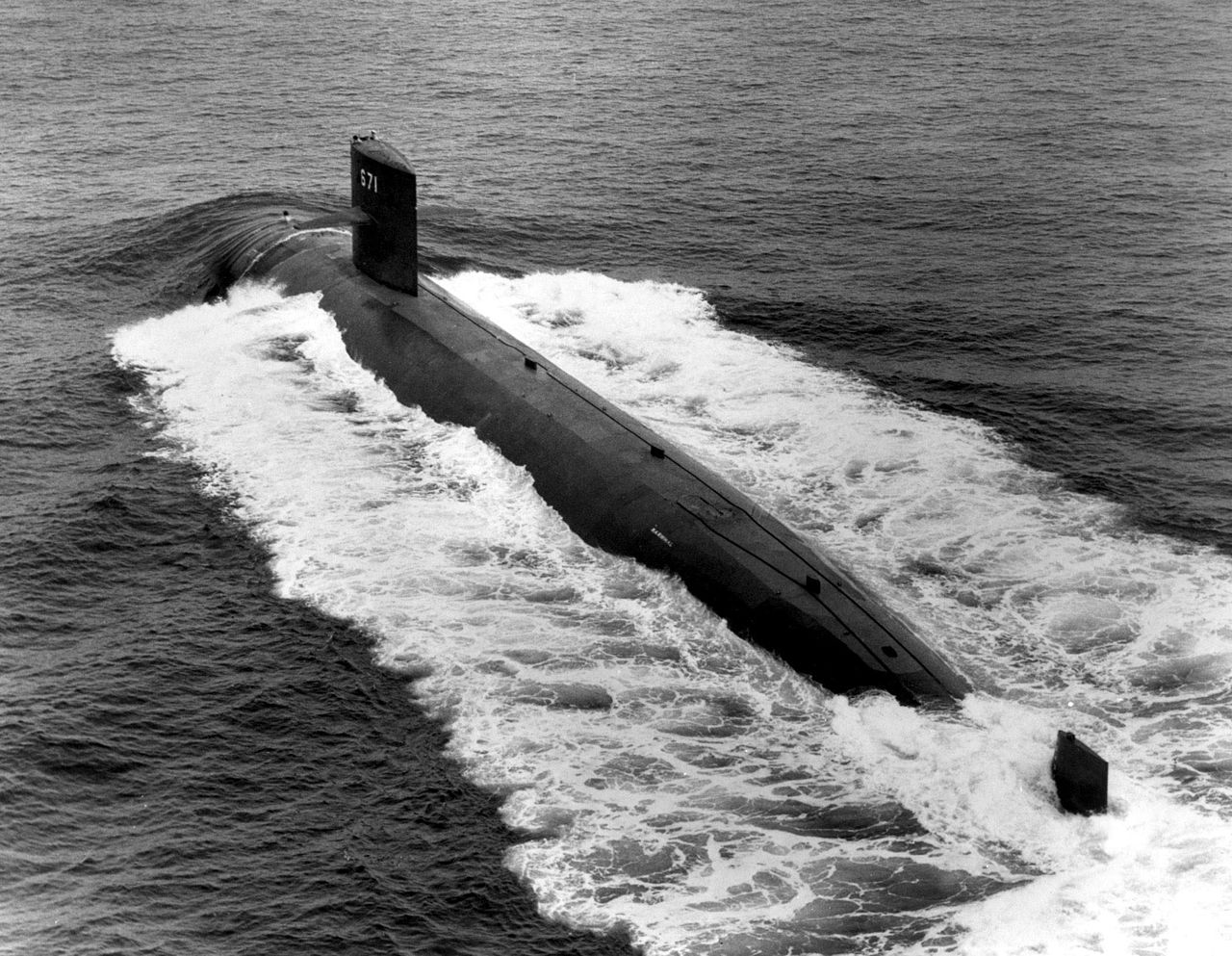
USS Narwhal
Other changes have been made to get rid of noise, the enemy of submarines. Early nuclear submarines were quite loud, with lots of noise from reactor pumps and gearing. Since the mid-60s, all nuclear boats have had their machinery mounted on noise-isolating rafts, which has helped the situation, but not solved it entirely. A nuclear submarine can't shut its reactor down completely while at sea6 so unlike a diesel boat, it will always make a bit of noise from the circulation of the coolant inside the reactor. Most reactors require pumps to aid this, although more recent submarine reactors are designed to operate at low power using natural circulation, based on the tendency of hot fluids to rise and cool ones to sink. The first submarine of this type, USS Narwhal, also had a direct-drive turbine to eliminate gear noise. She was said to spend more time on the coast of the Soviet Union than most of their navy. The Ohio class SSBNs also had natural-circulation reactors, and most modern SSNs have similar capabilities.
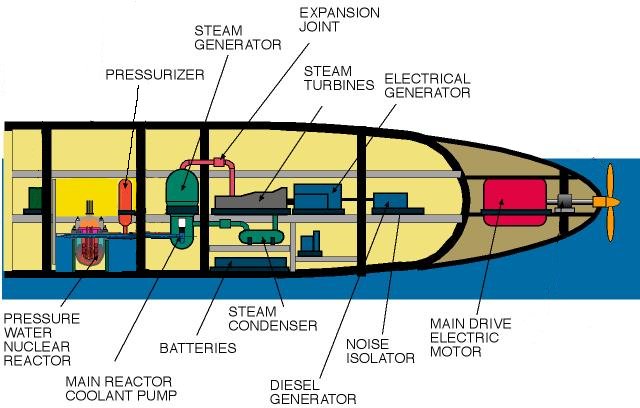
A turboelectric submarine reactor system
Another attempt to reduce noise was made with the use of turboelectric powerplants, which cut any mechanical linkage between the turbines and the propeller. Admiral Rickover favored this approach, but was only able to implement it on two submarines, the small Tullibee and the Glenard P. Lipscomb, where it proved larger, heavier and less reliable than geared turbines. The Soviets and French both used AC turboelectric drive, which Rickover had rejected due to theoretical complexity, quite successfully. Today, the same factors that have made integrated electric propulsion common on surface ships are at work undersea, and the upcoming Columbia and Dreadnought class SSBNs will make use of turboelectric drive, with some reports even suggesting that the motors will be mounted outside the pressure hull, removing the serious problem of passing the shafts through the hull. But whatever tweaks are made, it looks like the PWR will be the power source of choice for submarines well into the future.
1 I might cover air-independent propulsion efforts at some point, but it's not going to be here. ⇑
2 Weirdly, two different reactors were used for the Alfas. ⇑
3 During the debate over the Tico procurement (around 1980), it was estimated that an Aegis CGN would cost about $1.2 billion, as opposed to $800 million for a Tico. However, the former figure was first-of-class, so a more accurate value would probably be around $1 billion for follow-on ships, which is what the comparison Tico would have been. ⇑
4 The most recent information I have suggests that the premium in the late 2000s was around $600-800 million, with a break-even cost relative to conventional power, depending on how the ship was operated, with crude somewhere around $150/barrel. The lack of a suitable reactor for ships below 20,000 tons is likely to be a serious problem. ⇑
5 The NS prefix stands for Nuclear Ship. Other common prefixes include SS (Steam Ship) and MV (Motor Vessel). ⇑
6 OK, it can, but that's considered an emergency. ⇑

Comments
Rickover: "AC turboelectric drive is too theoretically complex! We can't do it!"
Soviets: "We figured it out.'
Rickover: [owned]
Also, I am going to have to work hard to resist turning this thread into a venting of my spleen against Rickover.
Not just the Soviets, the French figured it out, too. And I'm certainly not going to object if you decide to do an anti-Rickover rant here. He was definitely kept around too long.
Is there a rule of thumb for approximately how much more expensive a nuclear-powered ship is, compared to a similar conventional ship?
Also, is the extra cost mostly onboard the ship, or do they also require special and expensive shore facilities, which would drive up the cost of entry, but not necessarily the cost per hull afterwards?
Not really, because it's going to be super-variable depending on the circumstances. The best numbers I could find suggested that a nuclear equivalent to the Tico would cost around $1.2 billion (1980-ish) at a time when Ticos were coming in around $800 million. Dial out the first-of-class cost, and I'd think the follow-on CGN units would cost around $1 billion. But that was 40 years ago, and it might be a lot more expensive today, because we haven't built a nuclear surface ship since then, and a lot of the know-how has decayed. But it also depends on things like reactor availability. If you're willing to slap an A1B in there, then that could cut cost substantially.
Of course, now that this post is up, I go looking and find a major resource I missed earlier. They're estimating that the cost delta in 2006 was around $600-800 million, with procurement break-even being if oil is somewhere between $70 and $225/barrel.
Wouldn't nuclear-steam-turboelectric be absolutely enormous compared to nuclear-steam-gearing? Am I missing something, or is it just a sacrifice worth making for noise reduction?
It definitely was for Lipscomb, and it turned out not to be worth it at the time. Today, thanks to better electrical propulsion systems (see the rise of IEP) it apparently is worth it.
No notes, bean, well done. Looking forward to an AIP post.
echo, SSN/SSBN main reduction gears are enormous, spanning all three decks of the engine room, and enormously expensive--lore says the Navy only leases them from the manufacturer. I'd love for a historian to fact-check and expand on that....
I really doubt they're leased, as that doesn't seem to make a lot of sense for either the manufacturer or the Navy. But gears have always been expensive and difficult to manufacture. I took a look through Friedman, and he didn't mention anything about leasing. There were a few details on the gears, but not too much.
My understanding is that nuclear propulsion also massively improved the quality of life of submariners, who previously had to work in smelly, diesel-fume-soaked, low freeboard, wet submarines that had to surface too often.
Blackshoe said: "Also, I am going to have to work hard to resist turning this thread into a venting of my spleen against Rickover."
You won't have to resist too long however, Blackshoe as I am going to bring him up in the next open thread. I have finished the book and have some questions to tuck into. Perhaps they will offer you a springboard as I was struck by your colleagues discussion of him.
@bean Only skimmed it, but my takeaway from that pdf, was from the section about future medium surface combatants (around 20kt), where they estimated the cost would be about 1/3rd bigger for nuclear. Wondering if they've factored in the cost of the oiler (it eats fuel too, and has crews, and needs protection by other things that also eat fuel and have crews etc). Anyway, even a 50% cost increase that buys vastly increased, permanent power for systems and engines and no refueling sounds like a no-brainer. Is the hatred of all things nuclear that big a factor?
They don't seem to have factored in the cost of the oiler, although even with that it isn't a slam-dunk. Yes, the CGN is more useful than the CG, but 3 CGs give you more chances to have a ship on-site than 2 CGNs, and a CG on-site is more useful than a CGN a couple of days away, even if the CGN gets there a lot faster than a non-nuclear ship could. (Also, nuclear-powered ships do need auxiliaries, although not as much.) If I was SecNav, I'd be pushing NavSea to look very hard at an A1B powered ship for the Tico replacement, but I'm not and they probably won't.
Sodium cooled reactors seem to only work well when they are pool type while the S[1|2]G was a loop type reactor.
Is there any reason why a pool type reactor couldn't be used in a submarine?
AlexT:
Good luck on that, it depends on what type of ship it is (both technical characteristics as well as how you'll operate it), what type of reactor technology you're using, what type of dinosaur* burning technology you're comparing it to, what your regulatory environment is, how expensive oil is, how high your carbon taxes are, etc.
The current state is that diesel and gas turbine technology is really well developed and getting better along with highly automated, nuclear has been neglected with a regulatory structure designed with to protect fossil fuel market share rather than get the most benefit with the least total societal cost and Rickover's do everything manually culture, oil right now is pretty cheap (even without the pandemic it still wouldn't be all that expensive) and carbon taxes close to non-existent.
AlexT:
As I understand it most of the extra cost of NS Savannah over a dino-burner* was shore facilities it had all to itself.
bean:
bean:
What about the S1B?
AlexT:
A 50% cost increase probably can't be justified by that.
AlexT:
Probably not directly. But the astroturf campaign against nuclear power has caused nuclear engineering to become very conservative so we're still using PWRs even though we really should have replaced them with Gen IV designs.
bean:
I've seen accusations that some comparisons used unrealistic assumptions when comparing nuclear and fossil fuels, maybe that one did too.
* Yes, I know oil is actually dead marine animals.
@bean
In theory 2 columbia class reactors are a perfect power plant for a large surface combatant. life of ship core, minimal manning requirement, IEP setup, and the development costs are already paid.
@bean: I expect the French to figure out the engineering (indeed, a weird, quirky system seems like exactly what I would expect the French to do well). But the fact that the Soviets (given all their problems, granting that many of those problems were on the QC side vice pure engineering) were able to figure out to is hilarious to me.
@AlexT: bean kind of already beat me to it. The nukes I worked with always were able to give an answer for when conventional breaks even with nucular power, and it always suspiciously ended up being about 2.5 the cost of a barrel of oil. And that may be the actual costs are, or it may just be what NR says the costs should be.
As far as what the costs go into, there are three things that would drive up costs. Number 1 is construction capacity; right now I think there are two yard certified to construct nuclear ships, Newport News Shipbuilding in Newport News, VA, and Electric Boat in Groton, CT, with there being some supplemental capacity at lower levels. NNS seems like the much more likely option so as not to disrupt the submarine production cycle, and I think there's some excess capacity in there...but it's not without risk. Maybe you could make something work with different yards building different parts and then floating it all together somewhere? That sounds...fun.
Number 2 is maintenance costs; these ships will require extra maintenance (or perhaps better said, the Navy will have to pay for the maintenance they have designed them for, rather than shirking on it like they've done with the surface fleet).
But the big one is really crew, specifically the costs of recruiting, training, and retaining nuclear-trained personnel. I'll let ya'll in on a minor secret: the entire Navy line officer accession system is designed to produce nukes (that's why there's so much emphasis on STEM degrees), and most of the enlisted recruiting force is devoted to finding nukes as well. It's not easy to get people with good math/science skills who don't want to go to college and would rather be Navy Nukes. And it's really hard to retain them once we finish treating them like idiots for 4-6 years and then they realize they can make a lot of money on the outside, too. The bonuses we have to feed to recruit, and then retain people are a massive driver in costs. Sub officers were getting $250K for retention to another four years past their initial mark...and still only getting retention rates in the teens. Plus if you really wanted more platforms, you'd need to open up more training facilities, which is also super expensive.
IMHO, personnel costs really are the biggest obstacles for getting more surface nuke platforms. There are of course ways you could get around that (eg changing some of the way we operate and accepting more automation into the system). But those aren't risks NR is willing to countenance right now.
Size, weight, and the bit where the platform is moving all spring to mind.
I know that this happened several times back in the 60s, but I have no particular reason to distrust this one. Part of the issue is that unless we go heavy nuclear, we'll still need the oilers, and swapping, say, 10% of the surface escort force to nuclear isn't going to make huge savings there. The carriers are another matter.
Re the S1B, I’d expect there to be more engineering than for the A1B, as submarines and surface ships are rather different environments. Still, worth looking into.
@Blackshoe
It isn’t that Rickover thought the US couldn’t figure it out. It was that the diagram of AC turboelectric is messier than that for DC turboelectric, and so he directed that the US would use the later. Much of the initial development work on rafted gearing was done by the British, and adopted by the US when it became obvious that TE wouldn’t be ready for Thresher/Permit.
And this is why we might lose to the chinese, because we won't get out of our own damned way. Nuclear propulsion went from fantasy to Nautilus in less time than it would take us to certify a new yard to build nuclear ships. And that's insane, because there are solutions to all of these problems.
(A) Mandate the colombia reactor half half the engineering manning of existing designs
(B) Realize that with IEP, most of the people working on a ship don't need to be nuclear certified and remove those requirements for people who aren't actually working on the reactor
(C) Make every cadet take requirements for nuc school
(D) make nuc enlisted sign up for 6 years instead of 4, pay them more, don't have them do non-nuc jobs, and make more use of warrant officers on the model of flying warrants
(E) Get GE or some other company to start building S1Bs. Tell them that the US is going to need X of these a year from 20xx onward, and they're each going to get half the contract on the first batch. Subsequent batches will be split 60/40 based on performance on the previous batch.
We can have a nuclear navy if we want it. there are reasons not to have one, legitimate ones, but "we can't get out of our own way enough to manage it" shouldn't be one of them.
@cassander: we did option C in 2011 or so (when we forced 85% of NROTC freshmen to take STEM majors-all USNA students are already are tech majors, and my understanding is OCS has a pretty high bias towards tech majors in who they accept for most of their line officer programs). Option D has been the case since, man the 90s? Maybe earlier? Since I am aware of things, anyway. But expanding your candidate pool (related: why subs were opened up to women) has only limited value if you're still going to lose upwards of 3/4ths of them past initial MSR anyway, and if your only solution to retention is "I don't know, give them bigger bonuses?". Expanding warrant officer/LDO positions might be useful, but I'm not sure how easy that would be (you would basically be cannibalizing your senior enlisted workforce to make that happen anyway, and with the end of the legacy retirement system in 2018, I'm not sure how we're going to keep people very long past the initial commitment anyway). Options A* and B are where things need to go, but it's hard to get there. I always liked to note to the nukes that there is nothing in the laws of war that say that the people manning the engineering plant have to be military personnel, and that there are in fact ships in the USN-Battle Force ships, I should note, not MSC-where that is how is done. Nobody seems to like my plan to "Contract out all the nukes", strangely.
But yes, I do agree that This is Why We Will Lose the Next War (among many other reasons).
*-Related Nuke Joke: Why did Rickover force his wife to stay in the kitchen for her whole life? To verify that the oven did not inadvertently switch to the "On" position. This overstates but has some truth in regards to the old-school nuke manning mindset.
Blackshoe:
The US Navy operates nuclear submarines and aircraft carriers and so only really needs the places that build them to be nuclear qualified, making other surface ships nuclear powered would mean that other yards would have to be qualified as well and problems there if they exist are likely to be regulatory (i.e. can be gotten around easily if the political will exists).
Having only two yards be qualified is not really something I'd like in a war though but I suspect that getting others qualified would probably happen pretty quickly if a major war were happening.
Blackshoe:
The US Navy is known for having a very hard nuclear power school, maybe that's what they actually need to fix but the hardest part may be that they'd have Naval Nuke being viewed as about equivalent to jet engine fixer in terms of ASVAB score and social status which may be too much for their egos.
bean:
The first two probably aren't going to make it a show stopper, though the loop type reactor will look better on those criteria if you ignore the part about it not working properly but the third might be troublesome.
Or maybe it actually wouldn't be, a pool type submarine reactor is still going to be smaller than an A1B pressure vessel.
bean:
In terms of what would be relevant to a reactor they don't seem all that different.
I agree with anonymous re moving sub reactors to surface ships. All subs are at some level capable of surface operations, so I would think you would get most of the way there by just carrying the design over and changing the open side of the cooling circuit to deal with lower pressures. That being said, I suppose the main issue that Bean is getting at is either
However, I think the bigger potential issue is that a potential nuclear surface combatant doesn't really line up very well with extant power outputs. The A1B and A4W for the carriers are in the 120k hp class, while the various sub reactors are around 40k hp, all mechanical hp, not thermal. The Burkes currently have about 100k hp installed between their four LM2500s.
Assuming the future nuclear surface combatant is roughly the size/capacity of the Burke, it then seems like there are four options: 1. Go with a single A1B using IEP, which is somewhat bad for redundancy, but submarines are all single reactor ships and the Navy seems fine with them, so I don't think it's a deal breaker. You could add an LM2500 feeding the IEP for redundancy/emergency ops, and have it share fuel with the helicopter(s), so you're not toting around tens of thousands of gallons of fuel to no end. 2. Use 2x submarine reactors (80k hp total) and shrink the platform, but this seems bad in terms of capability growth. 3. Use 3x submarine reactors (120k hp total), is interesting but probably kills your operational and cost gains. 4. 2x custom designed 60k hp surface combatant reactors that can also power the next gen submarine. Interesting idea, but probably kills your economics because of the development costs.
Bonus question for discussion: Does redundancy actually provide a lot of additional reliability gains, assuming your goal is full operating capacity?
One of the things that is observed (at least in small airplanes) is that all of the common modes of failure (landing gear, wing structure, fuel exhaustion) are still the same, but you now have twice the chance of being down a single engine, while having half the chance of losing both engines.
Given the presumably limited utility of a surface combatant with only 50% power (i.e. it's headed direct to the shipyard, not limping along behind the battle group, trying to catch up), does one reactor with sufficient emergency power for firefighting, etc, actually end up worse than two reactors?
My kingdom for an edit button.
Also, with respect to IEP, it seems as though it would in some ways be easier to increase redundancy on the demand side, and to a lesser extent the (non-nuclear) parts of the generation side. E.g. you could drive two or four generators on different steam circuits, have multiplexed switch gear, and easily optimize the drivetrain for mechanical reliability and performance reliability, be it azi-pods, twin shafts, four shafts, or whatever.
redRover:
If go that route someone will try to make it CONAG and I'm skeptical as to whether it makes sense to combine nuclear with anything else given that the anything else isn't going to have the range to add any strategic mobility while tactical mobility (of the type the LCS has) is irrelevant if you can't outrun a strike aircraft.
redRover:
If it can fit in a submarine you can have a common reactor so the development cost would be spread over a lot of platforms.
redRover:
I thought it was the square of the chance of losing a single only engine which at least if the pilot can handle the plane on one engine is a massive improvement.
redRover:
With aircraft engines it was noticed that the auxiliaries were more likely to fail than the gas turbine so ETOPS requires at least two on each engine. I suspect the same thing is likely to apply to nuclear reactors.
The big potential issue with putting an S1B on a surface ship isn't things that you'd have to add, it's things you'd have to take off. A lot of sub-specific stuff doesn't really apply to surface ships, and I suspect that some of it would probably have to be removed. Still, you have a good basis to work from.
Yes, but they don't fit A1Bs on subs. So you're still driving up sub size, which is worse than driving up surface ship size for complicated reasons.
I don't think this is really true. Yes, a ship which can do 24 kts indefinitely and 30 kts for a few thousand nm is inferior to a ship which can do 30 kts indefinitely, but ships spend most of their time doing 20 kts or less and it's definitely superior to one which can't do 24 kts indefinitely. I actually think there's a lot of potential utility in combined nuclear plants for basically this reason. (Also worth pointing out that modern electronics use a lot of power. There's a noticeable decrease in range on a Burke or Tico when the radar is running, although I don't have figures to hand.) There are definitely tactical reasons why you want speeds of 28-32 kts, and the reason they don't go higher is because the cost is too high for the utility they get out of it, as the LCS has so graphically demonstrated.
How useful is speed as protection from torpedoes? If you can detect it and run away, it would reduce the torpedo's effective range, making things trickier for the submarine.
It's definitely useful for that. Most torpedoes are at most twice the speed of a ship, so by running away, you can cut range in half. But there's other stuff, too, or I expect I'd have heard them trading speed for the chimeral anti-torpedo defenses.
@alexander
Speed is VERY useful protection from torpedoes. An ADCAP has a (conservative) range of about 20 nautical miles at 50 knots, means it runs for less than a half hour. If you're running at 30 knots away, that cuts the effective range in half. And if you're a submarine with a quiet speed of 20kts, you probably won't even be able to get in range of an enemy ship moving at 25-30, at least not undetected.
During ww2, merchant ships moving at 15 knots were considered basically immune to submarine attack, which is probably why the modern amphib fleet is designed for 20kts. Modern diesel electric boats aren't all that much faster than WW2 ones (faster submerged, yes, but not overall) and can't run at those speeds for long on batteries.
Thanks you both Ü It sounds like having the power to achieve a high dash speed (or operate Laser CIWS) could make a ship a very hard target indeed.
Is there any remotely achievable speed for a warship where a supercavitating torpedo would have a greater effective range? I suppose that a high speed would let you dodge too, so some sort of guidance would be required.
bean:
Because they aren't nuclear powered, if the whole fleet were nuclear powered and capable of 30+ knots they'd probably be doing that whenever they don't have a good reason not to.
Alexander:
Could a supercavitating torpedo be guided? If not then you don't need speed, just the ability to turn.
But the whole fleet isn't nuclear powered, and isn't going to be for a long time, so a lot of the way it operates is still going to be set by things like not draining the fuel tanks on the Burkes. Also, I'm not so sure that they'd want to spend all that much time at 30 kts even if they were all-nuke. It's possible, sure, but I don't think they actually do it unless there's a reason, even if operating alone. Could be wrong on that, though.
bean:
But eventually it would be.
bean:
Attack submarines when operating alone seem to go fast whenever they aren't trying to hide (admittedly that'd be mostly when deploying or returning to base).
Are modern subs quiet, and able to listen, while going that fast? Was under the impression it was something like 5-10kts tops in quiet mode, and full throttle when they don't care who hears them.
@Anonymous
Submarines and surface ships operate very differently. Doing 30 kts on the surface is harder on the ship than 20, while a sub generally doesn't notice, outside the sonar suite.
@AlexT
Listening and making noise are two different things. Listening performance starts to suffer above 5-10 kts, AIUI, while noise for a modern submarine doesn't really spike until 20+, although the exact value depends on depth, because of cavitation.
As a somewhat belated clarification, the idea behind the accessory LM2500 (or another similar turbine) is to provide systems capability and minimal propulsion if the main plant goes down. It's not so much CONAG as nuclear with emergency functionality in the event of a scram or other loss of nuclear power.
Perhaps Bean or Blackshoe can give a better idea of the power requirements for that, but the Burkes have three Rolls Royce gas turbines for power generation (3400hp each), and the current submarine fleet have diesels for emergency propulsion.
I am not sure how much extra power is budgeted for fire pumps and stuff, but how do the carriers deal with that? (i.e. if the reactors go down, how do they keep systems running?) The turbine is intended more for that kind of contingency, rather than routine power augmentation.
The long pole in the electric power budget for a Burke is apparently the SPY-1 radar, at 6 MW. Or a bit over 8,000 shaft horsepower, if you're trading it off against propulsion. The new SPY-6 is more power-intensive, but details are classified and I assume it can keep to 6 MW when you're not actually engaging missiles.
I ran some quick numbers for a Burke Flight III with an S9G-derived reactor and a pair of late-model LM2500s feeding into an integrated electric propulsion system. Even assuming a 15% conversion loss through the IEP system, and a constant 10 MW electric load, I got 22 knots on the reactor alone and 33 knots on reactor + turbines. The Burke drivetrain is good for 33 knots, so we're not overstressing anything there.
That's almost certainly a net performance gain; the Burke is carrying 1,300 tons of fuel for its turbines, and the reactor system is almost certainly <1000 tons. Whether it's a net cost gain depends on whether the life cycle cost of an S9G produced at destroyer scale is lower than the net cost of all the fuel a Burke will burn cruising over its operational life.
It would be worth at least considering a flight of CONAG-IEP Burkes for e.g. carrier group duty; the conventional Burkes are fine for escorting 20-knot amphibious groups and most independent "presence" roles.
@john
that seems to imply that a single S1B would be almost enough to power the whole ship. I don't have specs for it, obviously, S8G puts out at least 50% more power than the S9G. The Colombias are going to be a decent chunk larger than the Ohios, and already have the IEP cost factored in. Are you sure you don't mean an S8G?
@bean
presumably you could build all nuclear task groups when you needed something fast.
@Cassander: A Burke is going to need at least 120,000 shp to keep up with a carrier while running Aegis; the system I scoped delivered 135,000 shp (into the electric generators) of which 40,000 shp comes from the S9G. It takes substantially less than half power to cruise at ~20 knots, compared to dashing at 30+.
I can't find numbers for the S1B, but the S8G looks to be 70,000 hp. And the reactor compartment is 2,750 tons; probably a fair bit lighter in a surface-ship version but still not likely to fit a Burke. So I don't think the S1B is the answer here. Unless it's somehow more powerful and lighter than the S8G and cheaper than the S9G, which is unlikely. The S9G(*) is the right power level for cruise + hotel load, and it plausibly fits a Burke, and we're going to be building them in quantity anyway.
For an all-nuclear solution you'd be looking at a single CVN-sized reactor or a pair of SSBN reactors, and I don't think that's going to fit a Burke hull either.
@john
Right, that's why I'm a bit confused, you've swapped out half the burke power plant (2 LM2500s producing ~30Khp each) for one reactor which produces about 40Khp, but still manage to hit 33kts while running the radar. I can absolutely see running the radar and cruising at 20kts on the smaller reactor, but if you want to hit ~130Khp, won't you need either the S8G and 2 LM2500s or the S9G and 3?
I definitely assumed that a S1B powered ship would need a new hull built around it, but I think that you'd want a new hull to take advantage of IEP anyway.
@Cassander: An S9G give 40,000 shp. A 21st-century LM2500 provides 47,500 shp. One of the former plus two of the latter gives 135,000 shp. To get that, I propose giving up all four antique 20th-century LM2500s that were only rated at 33,500 shp.
@john
Ah, got it. I didn't realize the new ones had been uprated by that much.
@Cassander: And there's never been any point in upgrading to the new turbines, because the propellers, shafts, gearboxes, etc, were all designed around the original LM2500.
Interestingly, the old CGNs (FFGNs, DLGNs, whatever) seem to have reached 30+ knots on 60,000 shp. Partly because they didn't have to give up 8,000 horsepower to run the radar, but mostly because they were longer and running much closer to their hull speed rather than climbing their own bow wave. So that's something else we'd want to throw into the trade space if we were taking a serious look at this.
I always wondered how the Burkes ended up looking like that, other than being the best shape for seakeeping given the size.
Interesting thesis on lengthening repeat Burkes for efficiency.
There was a bunch of interest in alternative hullforms in the 80s, most notably the "short fat ship" concept. The more extreme form was seriously investigated by the British, and the report was apparently scathing, but I think some of the same ideas ended up in the Burke design. Also, seakeeping. But I am rather surprised they haven't lengthened them any time in the last 30 years.
They'll probably just make longer Burkes when they replace the CGs which whilst increasing hull efficiency and providing more space and displacement would make turning them into CGNs easier they'll probably end up COGAG with IEP.
I thought you were joking about the term until I googled it, wow. Apparently the report was scathing enough to trigger a libel lawsuit against the Lloyd’s analysts! (although the threshold for that is pretty low in the UK...)
I get the impression that the Short & Fat argument was that a beamy ship gives more interior and deck space for structural cost. Given that ships spend most of their time at ~20 knots, it doesn’t make sense to shape the hull around efficiency at flank speed when you can just throw extra engines at the problem. And since viscosity(?) matters more at slow speeds than wave-making resistance(?), you may as well just build your destroyer like a high powered tanker(???)
At that point I gave up trying to understand the theory, because it wasn’t justifying what I wanted, which is this absolutely beautiful Long Beach Aegis cruiser
Sadly I’m sure they’ll manage to make the new one look like a bloody Zumwalt regardless.
It gives more space for the structural cost is the motte for those particular claims. The bailey is apparently rather wacky. The guy I learned about this from said the ideas came around on a predictable schedule, and someone read some praise of the short fat ship concept at a meeting that he later revealed was about a century old, and from a previous go-round on the idea. One of these days, I need to get my hands on a copy of that report.
@echo
That is a real pretty ship. Replace the arm launchers with ~128 VLS cells and I'll take 20 please.
But good on you for not letting anything as sordid as physics get in the way of a beautiful dream.
http://www.rp-one.net/shipbucketprofiles/profilesseasb1.html#image_13 looks like the short and fat ship proposal, I doubt it'd win aesthetics prizes were it built.
That last link from Anonymous is 404
But of more interest, what was the full Bailey for the Short Fat Ship?
I found the page by searching. Try this link instead:
http://rp-one.net/shipbucketprofiles/profilesseasb1.html
As the previous link suggests, it's the thirteenth image on the page (or you can search 'short fat ship'). Its a profile view, so demonstrates the shortness better than the fatness.
Okay, that doesn't work either. Try typing 'rp-one.net' into the address bar, and clicking 'warship profiles'. If that doesn't work, you can search 's90 Sirius short fat ship'. I wouldn't want to oversell the image though, its just a profile of a short ship.
Markdown strikes again :p
Thank you Ü
OK. I've done a bit of reading, and it wasn't really a motte and bailey. The ideas behind the Burke hullform were fundamentally different from those behind the S-90. That was based on the idea that Thornycraft, Giles and Associates had discovered some new principle of hydrodynamics, which would let their ship plane on an even keel, and could let the vessel, which had an L/B of like 4:1 (very short compared to anything not from the 19th century) make the speed required to be a viable alternative to the design that became the Type 23. They made enough noise for the scathing parliamentary inquiry, but didn't learn their lesson, and tried to sell it to Lockheed Martin for the LCS. Someone was tipped off, because Lockheed essentially said "and we've partnered with Thornycraft, Giles and Associates to use their revolutionary new hullform..." and got the report of the inquiry slammed down on the table in front of them. The Lockheed design eventually ended up as the LCS-1, which is more conventional.
Yeah, I ran into the "planing" thing and wondered how it ever got past the drawing board. Some dude making claims SFSes could make 60 knots with One Weird Trick (Navy Insiders Hate Him!)
I thought the Burke hull form might come from experience taunting the Soviets in the northern seas, but seems like it was designed a bit early for that.
It kinda looks like the distinct "V all the way up" shape might have been inspired by them though?
Must be pretty stable compared to an overloaded Tico. I wonder if we have anyone here who's been on both in rough weather?
Chemistry nit-pick: Sodium is not corrosive; it is corrodeable. It provides cathodeic protection to any metal part it touches. True, you have the caustic smoke (that can cut through flesh like a knife) and an alarming tendency to catch fire at the slightest provocation, but your steel parts will be rust free. : )
I would assume that the sodium had a lot to do with all of the trouble they had with leaks, above and beyond it just being bad when leaks happen. They control water chemistry in PWRs too precisely for that to be the case. I can't think of a better word than "corrosive" for that.
On reflection, you make a good point about its tendency to eat joint packing.